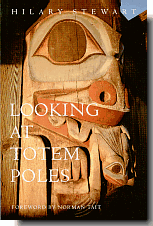|
|
|
First Nation Artefacts of British Columbia
|
|
|
|
Bentwood box, Haida The boxes are made from a single plank of cedar wood, wich is first notched or kerfed to mark three of the four corners. The plank is steamed until the moisture permeates the wood, making it pliable enough to bend. The plank is then carefully bent into the shape of a box.
|
Kerfed dishes such as this one were useful as well as beautiful. On festive occasions they might hold fish, berries, or other food or they could be used for cooking. Designs on the boxes often encompass a whole creature, the front and side view here depict the head and body of a bird. |
| The Raven and the First Man is the highlight of the visit to the museum. It was carved from a laminated block of yellow cedar, the sculpture depicts a Haida myth of the Raven discovering mankind in a giant clamshell. (click on the picture for a better view.) |
The Raven and the First Man by Bill Reid, 1980 |
 |
To the Northwest Coast Indians, the totem pole provided a means of communicating their stories, myths and legends. The totem pole is an arrangement of symbols or memory devices in sequence created for the purpose of recalling a story or event. These symbols function as a form of “writing”—pictures, not written letters, convey meaning. Further, these stories conveyed symbolically a visual expression of what the Indian culture meant. Indian stories represent ideas that are important to Indian society. |
Totem poles with their overwhelming stature, undulating carvings covered with magnificent symbols full of mystery and intrigue, and subdued colours, (red, white and black) strike an impressive pose. Totem poles, like Kachina Masks of the Southwest Indians, the Pyramids of Egyptians, or Stonehenge in England, are striking symbols of the past.
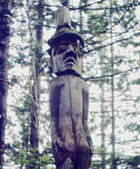 Geographical
Location
Geographical
LocationThe north western coast of North America is the geographical area which gave birth to the totem pole. This small stretch of land from the Puget Sound to approximately 200 miles northwest of Juneau, Alaska, is only a thousand miles long and in spots only one hundred miles wide. The area is referred to as the Totempolar Region for it is the only region in the world that has produced the totem pole.
Warm Oriental ocean currents create a mild climate and produce an excess of humidity. Under these favourable climatic conditions natural vegetation and jungle like forests of cedar, spruce and fir thrive. As a result of the area’s being rich in natural resources and having an abundant food supply (such as game, salmon, fruits and berries) the local inhabitants had no need to practice agriculture. By not having to produce or cultivate their food supply, the Indians had a great deal of leisure time. This leisure time coupled with available wood as an art medium were crucial factors in the development of the totem pole.
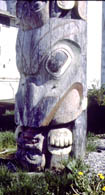 The
Inhabitants
The
InhabitantsFive major linguistic groups or tribes, all of which carved totem poles, inhabit the Totempolar Region. “The totem nations in Alaska were the Tlingit and Haida. The Quilliute and coast Salish nations were in what is now Washington and Oregon, and the Kwakiutl, Nootka, Bella Coola and Tsimsyan nations were in British Columbia.” These Northwest Coast Indians bear a resemblance to Asiatic people. Some Indians were documented as having Fu Manchu style mustaches, an unusual feature since other North American Indians seldom had facial or body hair.
Physically and culturally, the tribes were similar, and intermarriage was frequent. However, the tribes were not organized into a nation. Jealousy of power was so strong that no one leader could overcome it enough to impose his leadership on a linguistic group.
All tribes were divided into a four class social system
composed of royalty, nobility, commonality and slavery. Royalty consisted of a chief and his first nephews who
would succeed him. The nobility class consisted of younger nephews and their
families, plus people who had distinguished themselves in some way. Commonality
or common people were the free men related to the nobility by blood but who were
poor. Commoners could rise to a higher social station through the accumulation
of wealth. Rivalry with this group was intense. Slaves made up the lowest social
group. These were men and women who were either born into slavery or captured in
slave raids.
commonality and slavery. Royalty consisted of a chief and his first nephews who
would succeed him. The nobility class consisted of younger nephews and their
families, plus people who had distinguished themselves in some way. Commonality
or common people were the free men related to the nobility by blood but who were
poor. Commoners could rise to a higher social station through the accumulation
of wealth. Rivalry with this group was intense. Slaves made up the lowest social
group. These were men and women who were either born into slavery or captured in
slave raids.![]()
The clan was the strongest group within the tribe. A
clan was a group of people bound together by a tradition of first ancestors.
Each clan was headed by a chief. Hereditary descent was recognized from the
maternal side of the family. Male children at a very early age were sent to live with and be raised by their
maternal uncle. The children bore his name, his totem symbol and inherited all
the uncle’s property, wives, and debts owed him upon his death.
children at a very early age were sent to live with and be raised by their
maternal uncle. The children bore his name, his totem symbol and inherited all
the uncle’s property, wives, and debts owed him upon his death.
Living conditions fitted social station. All classes of a clan lived in the same community house, which resembled a roofed village with a communal fire. The chief occupied the rear of the house followed by the nobility class. Less desirable areas belonged to the commoners, and the slaves slept in the entrance way.
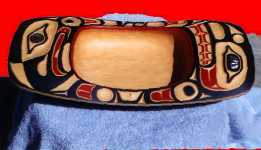 The
Northwest Coast Indians, unlike most other Indians, placed great importance on
ownership, acquisition of property and the flaunting of wealth. They were a
totally ostentatious society, living in an atmosphere of competition and lacking
in community spirit. Living on a system of credit forced them to become
preoccupied with debt and the payment thereof. Even after death, debts and shame
lived on. Wealth was measured by the number of totem poles, blankets, capes,
furs, carved boats and copper disks one owned.
The
Northwest Coast Indians, unlike most other Indians, placed great importance on
ownership, acquisition of property and the flaunting of wealth. They were a
totally ostentatious society, living in an atmosphere of competition and lacking
in community spirit. Living on a system of credit forced them to become
preoccupied with debt and the payment thereof. Even after death, debts and shame
lived on. Wealth was measured by the number of totem poles, blankets, capes,
furs, carved boats and copper disks one owned.
Indian religious practices were not immediately
apparent. They worshipped no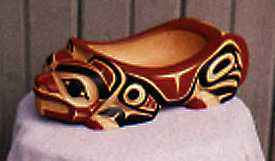 single deity, offered no sacrifices, lacked an organized priesthood, had no
houses of worship or idols, and practiced no congregational worship. They
believed all things around them possessed spirits which could help or hurt them.
Numerous taboos had to be observed to appease these spirits and secure their
goodwill. These taboos were always concerned with waste and hoarding. An example
of a taboo diligently observed was, “Salmon should not be kept for more than
one year. To do so would be to deprive the salmon of natural life and his spirit
could not be released.” If this taboo was broken, the Indians feared that the
Salmon would leave the area.
single deity, offered no sacrifices, lacked an organized priesthood, had no
houses of worship or idols, and practiced no congregational worship. They
believed all things around them possessed spirits which could help or hurt them.
Numerous taboos had to be observed to appease these spirits and secure their
goodwill. These taboos were always concerned with waste and hoarding. An example
of a taboo diligently observed was, “Salmon should not be kept for more than
one year. To do so would be to deprive the salmon of natural life and his spirit
could not be released.” If this taboo was broken, the Indians feared that the
Salmon would leave the area. 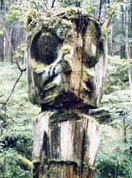 The
Indians believed in an afterlife and they practiced cremation. The body of the
deceased was burned and the ashes placed at the top of a totem pole.
The
Indians believed in an afterlife and they practiced cremation. The body of the
deceased was burned and the ashes placed at the top of a totem pole.
Their art and customs reveal an
Oriental influence. The Indian ceremonial clothing shares similarities with
Chinese Mandarin Robes, and they have carved wooden hats resembling Coolie hats.
Experts have offered various speculations as to the origin of this Oriental
influence. One speculation is that in historic times Japanese fishing vessels had been blown to these shores via the Japan current which swept into
this area. Chesley notes in his book Americans Before Columbus, “that
this strange Northwest Coast Indian culture was some accidental development of a
seed from Japan with its powerful feudal nobility system and its emphasis upon
forms of personal pride which are called facesaving”. Can it be that “art
styles may be introduced to a people thousands of miles from the originators
with no other intermediary but the ocean?”
vessels had been blown to these shores via the Japan current which swept into
this area. Chesley notes in his book Americans Before Columbus, “that
this strange Northwest Coast Indian culture was some accidental development of a
seed from Japan with its powerful feudal nobility system and its emphasis upon
forms of personal pride which are called facesaving”. Can it be that “art
styles may be introduced to a people thousands of miles from the originators
with no other intermediary but the ocean?”
The Indian artist practiced a conventional art style as
opposed to a representational style. Representational art shows the object as
the artist sees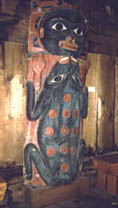 it. There
is poetic license involved. Conventional art follows certain formal rules or
conventions which are often centuries old. Stated beautifully by Reid in his
book entitled Out of the Silence, “It was an austere, sophisticated
art. It’s prevailing mood was classical control yet it characterized even the
simplest objects of daily life. These seagoing hunters took the entire
environment as art form.”
it. There
is poetic license involved. Conventional art follows certain formal rules or
conventions which are often centuries old. Stated beautifully by Reid in his
book entitled Out of the Silence, “It was an austere, sophisticated
art. It’s prevailing mood was classical control yet it characterized even the
simplest objects of daily life. These seagoing hunters took the entire
environment as art form.”
Indian love for ostentation and display is evidenced in
their highly decorative style. More meant better, and they disliked vacant
space, straight lines and sharp angles. A main 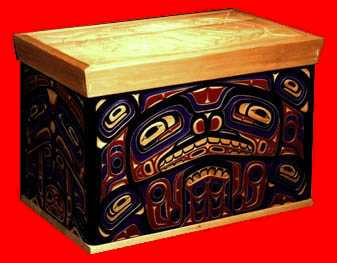 requirement
was that their art serve a useful end. Objects such as spoons, drums, dishes and
blankets were heavily decorated. But artists were restrained by the size and
shape of their objects. This restriction led to an almost complete disregard for
perspective. “To create within these limitations the artist employed
dissection, rearrangement of parts and distortion. Certain parts were greatly
enlarged or eliminated, others suppressed, bent or folded until they fit into
their allotted space”. Balanced designs were desirable and to achieve balance
the artist employed dissection. For example, to fit Raven on a drum, “the
Raven might be split down the back and laid open resulting in a two headed Raven
which did not exist in Indian mythology.” If an entire symbol could not be
made to fit as a whole, the symbol was chopped and the pieces placed randomly in
the area. This chopping process could result in a design having eyes placed next
to legs.
requirement
was that their art serve a useful end. Objects such as spoons, drums, dishes and
blankets were heavily decorated. But artists were restrained by the size and
shape of their objects. This restriction led to an almost complete disregard for
perspective. “To create within these limitations the artist employed
dissection, rearrangement of parts and distortion. Certain parts were greatly
enlarged or eliminated, others suppressed, bent or folded until they fit into
their allotted space”. Balanced designs were desirable and to achieve balance
the artist employed dissection. For example, to fit Raven on a drum, “the
Raven might be split down the back and laid open resulting in a two headed Raven
which did not exist in Indian mythology.” If an entire symbol could not be
made to fit as a whole, the symbol was chopped and the pieces placed randomly in
the area. This chopping process could result in a design having eyes placed next
to legs.
 The
Indian artist was always conscious of the skeletal form. Each joint such as a
knee or elbow was represented by an eye form. If the joint was large the eye
form became a face. Empty spaces were always filled with either eyes, flicker
feather designs or toads. It is difficult to separate space fillers from main
characters unless one is familiar with the tale the pole represents. Animals and
supernatural beings were carved with ears prominently placed on the tops of
their heads while humans had their ears carved on the sides of the heads.
The
Indian artist was always conscious of the skeletal form. Each joint such as a
knee or elbow was represented by an eye form. If the joint was large the eye
form became a face. Empty spaces were always filled with either eyes, flicker
feather designs or toads. It is difficult to separate space fillers from main
characters unless one is familiar with the tale the pole represents. Animals and
supernatural beings were carved with ears prominently placed on the tops of
their heads while humans had their ears carved on the sides of the heads.
The Indians believed birds, insects, fish and animals could become human at will. In their art, there is always a clue to expose the artist’s intent. If an artist were portraying a whale in human form:, he might place a blow hole in the forehead; a raven in human form would be a face with a beak; an octopus might be a face with tentacles for eyebrows.
A system to identify important figures was developed by the Indians. In this system the salient feature of the totem animal was stressed.
“Like Heraldic crests, these poles told of the mythological beginnings of the great families, at a time before time, when animals and mythic beasts and men lived as equals and all that was to be was established by the play of raven and eagle, bear and wolf, frog and beaver, thunderbird and whale.” “They told the people of the completeness of their culture, the continuing lineages of the Great families, their closeness to the magic world of myth and legend.” “The legends usually deal with the exploits of Raven, tales of migration, the flood, intertribal wars and early contact with white men.”
These totems appear in six different settings, which
are common to all five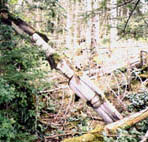 tribes. They are all carved from red cedar in the conventional art style. Totem
poles were public documents raised to recall legends or validate events and the
difference between the six types lie in the purpose for which they were erected.
tribes. They are all carved from red cedar in the conventional art style. Totem
poles were public documents raised to recall legends or validate events and the
difference between the six types lie in the purpose for which they were erected.
The six types are as follows:
|
1. |
House pillars and false house pillars supported the rafters in the large communal houses. |
|
2. |
Mortuary poles were simply painted poles on top of which were placed a box containing the ashes of the deceased. Later the ashes were removed and replaced with a totem. |
|
3. |
Memorial poles were raised to honour both the living and the dead. |
|
4. |
Heraldic portal or family poles were placed in the middle front of a house with a hole near the base which served as a doorway. The pole was carved with the mythological history of the clan within. Its purpose was to advertise and exalt the lineage. |
|
5. |
The Potlatch pole was designed to record and validate important events. Potlatch in Indian means “story master”. These are the tallest (6080 feet) and the most elaborately decorated poles. They are distinguished by having one to three high hatted watchmen at the top. Beneath the watchmen is the chief’s totem, then his myth and then his wife’s totem. |
|
6. |
The Ridicule or Shame pole was erected to force some person of high standing to meet or recognize an obligation. Many white men are carved on these poles. Another form of shaming a person was to carve his totem upside down.” |
There are no hidden meanings in a totem pole but lots of cultural ones: hence those outside the culture may not be able to make connections. Totem poles are more social than religious and share nothing in common with idols, are never worshipped and never figure in religious ceremonies. The symbols only serve as memory devices to recall a story. It is important to point out once again that these stories reflect the unifying factors of the culture and hence to read a totem pole it is necessary to understand Indian mythology. This is not an easy task. Some myths were collected and published, others are lost for all time. In many cases young Indians are not taught the myths and older tribesmen are reluctant to discuss them. “Indians respect and honour the property right of a story. One could not sing a song which is the property of another nor dance his dance, nor tell his story.”
The following list is what Indian scholars consider necessary to fully analyse the totem pole. To read a totem pole certain basic facts should be predetermined:
1. Determine what linguistic group made the pole.
2. Ascertain the type of pole, mortuary, heraldic.
3. Locate and study tribal myths.
4. Identify each figure.
5. Determine which characters are part of the story and which are space fillers.
6. Recall the myth starting from the top.
Totem poles are read from top to bottom. The principal character, clan, orphratry symbol was placed on top. Following this are the characters and objects which recall the legend and at the base of the pole is carved the wife’s clan symbol.
Carvers had no say in their work. They were artists hired to do exactly as directed by the totem pole’s owner. After the owner selected his tree the first step was to hollow it out. This work made the tree more mobile, and by removing the heartwood, more resistant to checking. The tree was marked off into equal sections. Sometimes different carvers were used for different sections. Separate payment was made for each carved section. After carvings were completed, a uniform texture was applied to the entire surface by scooping out dimesized uniform chips.
Totem poles were painted with a type of fish egg tempera and colors were limited to subdued shades of red, black, green, and blue. European paints were introduced in 1830 and poles produced after this time displayed a variety of brighter colors.
In 1820, the iron adze was introduced by the Northwest traders. As a result of this addition, the period from 18301880 is referred to as the Golden Age of Totem Poles. This period witnessed the finest and the tallest poles (between 6080 feet) ever constructed.
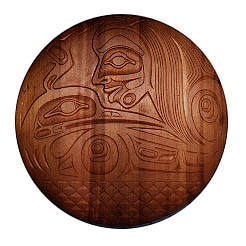 Raising
the finished pole was a great social event called a Potlatch. The purpose of
this party was to build up the reputation and social standing of the host. The
erected pole would remain to give witness to the celebration that took place.
Winter was the time for Potlatch as summer was a time to gather food.
Raising
the finished pole was a great social event called a Potlatch. The purpose of
this party was to build up the reputation and social standing of the host. The
erected pole would remain to give witness to the celebration that took place.
Winter was the time for Potlatch as summer was a time to gather food. 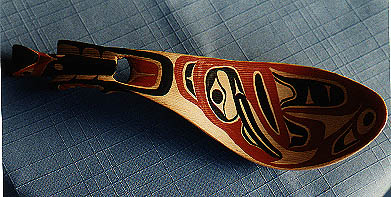 Preparations
for this feast took several years and the actual celebration could last for
months or even years. It was an expensive event to which only the very rich
could subscribe. Hosts were required to provide each guest with a daily gift in
addition to their food. There were two reasons why an Indian would spend this
great sum of money. First, he would pay off his debts with great ceremony and
personal honour; second he would indebt his guests by giving gifts to them.
These gifts were considered
Preparations
for this feast took several years and the actual celebration could last for
months or even years. It was an expensive event to which only the very rich
could subscribe. Hosts were required to provide each guest with a daily gift in
addition to their food. There were two reasons why an Indian would spend this
great sum of money. First, he would pay off his debts with great ceremony and
personal honour; second he would indebt his guests by giving gifts to them.
These gifts were considered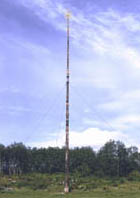 loans. After several years these loans must be paid back with interest to the
host or his heirs. Hence Potlatches served as a type of Indian life insurance.
Our term “Indian giver” is derived from this celebration. Although Indian
giver is a derogatory term, the practice from which it was derived was not.
loans. After several years these loans must be paid back with interest to the
host or his heirs. Hence Potlatches served as a type of Indian life insurance.
Our term “Indian giver” is derived from this celebration. Although Indian
giver is a derogatory term, the practice from which it was derived was not.
 Once
a pole was erected, it was never repaired or repainted. It was left to fall prey
to the elements. “Indians could not engage in repairs except with great
formality and expense and no new honors realized.” Socially and economically
it was cheaper to erect a new pole. Totem poles were personal monuments that the
Indians seemed content to have last only one man’s lifetime.
Once
a pole was erected, it was never repaired or repainted. It was left to fall prey
to the elements. “Indians could not engage in repairs except with great
formality and expense and no new honors realized.” Socially and economically
it was cheaper to erect a new pole. Totem poles were personal monuments that the
Indians seemed content to have last only one man’s lifetime.
Print on card stock paper.
Information gathered from this book.......
